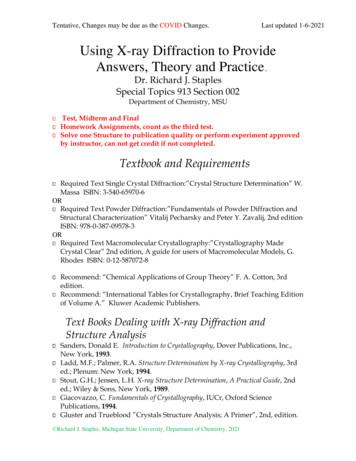X-Ray Diffraction And Crystal StructureX-Ray Diffraction .
X-Ray Diffraction and Crystal Structure
X-Ray Diffraction and Crystal Structure (XRD)X-ray diffraction (XRD) is one of the most important non-destructive tools toanalyse all kinds of matter - ranging from fluids, to powders and crystals. Fromresearch to production and engineering, XRD is an indispensible method forstructural materials characterization and quality control which makes use of theDebye-Scherrer method. This technique uses X-ray (or neutron) diffraction onpowder or microcrystalline samples, where ideally every possible crystallineorientation is represented equally. The resulting orientational averaging causesthe three dimensional reciprocal space that is studied in single crystal diffractionto be projected onto a single dimension. One describes the three dimensionalspace with reciprocal axes x*,y* and z* or alternatively in spherical coordinates q,φ*, χ*. The Debye-Scherrer method averages over φ* and χ* and only q remains asan important measurable quantity. To eliminate effects of texturing and to achievetrue randomness one rotates the sample orientation. In the socalled diffractogramthe diffracted intensity is shown as function either of the scattering angle 2θ or asa function of the scattering vector q which makes it independent of the used X-raywavelength. The diffractogram is like a unique “fingerprint” of materials.This method gives laboratories the ability to quickly analyze unknown materialsand characterize them in such fields as metallurgy, mineralogy, forensic science,archeology and the biological and pharmazeutical sciences. Identification isperformed by comparison of the diffractogram to known standards or tointernational databases.
DetectorHVWater Pump and SupplyDataOutputX-Ray SourceSampleElectronic Circuit PanelHV Power SupplyAngle ControlComputer
UtilityBinary MeasurementWavelengthTableDisplayRigaku ControlPanelMiniflex IIRight SystemManualMeasurementStandardMeasurementPeak SearchStandard DataProcessingIntegralIntensityMulti RecordApplication DataProcessingPresentPosition
X-Ray Diffraction (XRD) and Crystal Structure : Required Knowledge¾ Bragg’s relation for X-ray scattering¾Principles of a Bragg spectrometer¾ Max von Laue and Bragg method¾X-ray tube and X-ray production¾ Debye-Scherrer technique¾X-ray optics, slits, Soller slits,X-ray reflexion¾ Crystal lattice and reciprocal space¾ Lattice parameters¾Wavelength discrimination¾ Identification of compounds¾X-ray detectors¾ Powder Diffraction File (PDF)¾Sample preparation¾ Cambridge¾Compare with Neutron Diffraction¾Application of the XRD method toStructuralDatabase(CSD)¾ Electron density determinationdifferent other fields
X-Ray Diffraction and Crystal Structure : Tasks and Goals¾ Set-up¾Measure energy¾ Produce¾Determine¾ Set-up¾Compare energy¾ DetermineWARNINGS¾ Determine¾Be careful.¾ Determine energy¾Shut down¾ Determine the¾Never touch¾Remove source after measurement
The RIGAKU MINIFLEX IIX-ray diffractometer
Vitamins are another group of materials commonly tested with XRD. The wrongpolymorph of a vitamin is usually inert and provides no benefit to the consumer. Forexample, the B vitamin pantothenic acid has two polymorphs, one of which is inert. Thedata in Figure 2 is from a B-complex vitamin supplement. Using XRD it is possible toidentify each component, and whether the correct polymorph is present to ensure properpotency.Measured XRD pattern of a B-complex vitamin supplement
Simulated XRD patterns of cocaine-maltose mixturesSimulated diffraction patterns of cocaine and maltose are displayed along with the peakpositions of the International Centre for Diffraction Data (ICDD) standard. Two mixtures, 50%cocaine / 50% maltose and 10% cocaine / 90% maltose, show the qualitative differences inthe XRD pattern as the components are varied. Qualitative identification is based on thepresence of the unique diffraction lines for each substance, the "X-ray fingerprint." Inaddition, a quantitative determination can be made for each component by measuring itspeak intensity and comparing it to the intensities measured from one or more samples ofknown concentration.
General XRD phase/composition identificationanalysisGeneral X-ray diffractionphase/composition identification will distinguish themajor, minor, and tracecompounds present in asample. The data usuallyincludes mineral (common)name of the substance,chemical formula, crystalline system, and referencepattern number from theICDD International database. A summary table ofanalysis results and diffraction plot with referencepattern markers for visualcomparison is shown below.Minor phasesMinor phasesTrace phasesAnhydrite,CaSO4 - orthorhombicICDD # 72-0916Calcite,syn CaCO3 - rhombohedralICDD # 05-0586Portlandite,syn, Ca(OH)2 - hexagonalICDD # 44-1181Gypsum,syn CaSO4.2H2O - monoclinicICDD # 33-031Brucite,Mg(OH)2 - hexagonalICDD # 74-2220Quartz,SiO2 - hexagonalICDD # 64-0312
X-Ray Diffraction and Crystal Structure (XRD) X-ray diffraction (XRD) is one of the most important non-destructive tools to analyse all kinds of matter - ranging from fluids, to powders and crystals. From research to production and engineering, XRD is an indispensible method for
Diffraction of Waves by Crystals crystal structure through the diffraction of photons (X-ray), nuetronsandelectrons. 18 Diffraction X-ray Neutron Electron The general princibles will be the same for each type of waves.
Single crystal diffraction with x-ray (and neutrons) Dinnebier Pre9. Dinnebier Pre6 X-ray hitting condensed matter Laue equation: Q hkl k f-k i . Imaging of reciprocal planes by high-energy x-ray diffraction Sc-Zn q x (Å )-1
We simulate XFEL spectra after diffraction on a bent crystal and show that an energy resolution of 3 10 6,or 0.04 eV for the X-ray energy of 12 keV, can be reached on diffraction on a 20 mm-thick diamond crystal bent to a radius of10 cm.Wealsotakeintoaccountthefree-spacepropagation of the waves diffracted by the bent crystal to the detector
History of Single Crystal Diffraction Safety Concerns in X-ray Diffraction Experiments. -Register to get a badge -Exposure -Regulations -Safety Devices Distribute Homework 1 January 27, L3. Growing Crystals. Mounting, Evaluation Key factors in obtaining good crystals. Read: “Crystal Growing”, Peter G. Jones, Chemistry in Britain, 17 (1981 .
Plane transmission diffraction grating Mercury-lamp Spirit level Theory If a parallel beam of monochromatic light is incident normally on the face of a plane transmission diffraction grating, bright diffraction maxima are observed on the other side of the grating. These diffraction maxima satisfy the grating condition : a b sin n n , (1)
Fundamentals of X-Ray Diffraction NaCl crystal In a diffraction experiment a source of X-rays generates a beam with a particular wavelength (see slides 30 and 31) interacts with the periodic structure of a crystalline sample, generating a number of diffracted rays which are collected by a X-ray detector (see slides 34 and 35). X-ray source
law relating X-ray diffraction to crystal structure. In 1913, fellow physicist Henry Moseley from the University of Oxford, UK, put Bragg’s diffraction law to good use, building a spectrometer to measure the X-ray spectra of elements, based on their diffraction through crystals. Moseley’s X-ray spectrometer used an X-ray tube, potassium
Anatomy and Physiology for Sports Massage 11. LEVEL: 3: Term: Definition: Visuals: Cytoplasm Within cells, the cytoplasm is made up of a jelly-like fluid (called the cytosol) and other : structures that surround the nucleus. Cytoskeleton The cytoskeleton is a network of long fibres that make up the cell’s structural framework. The cytoskeleton has several critical functions, including .























